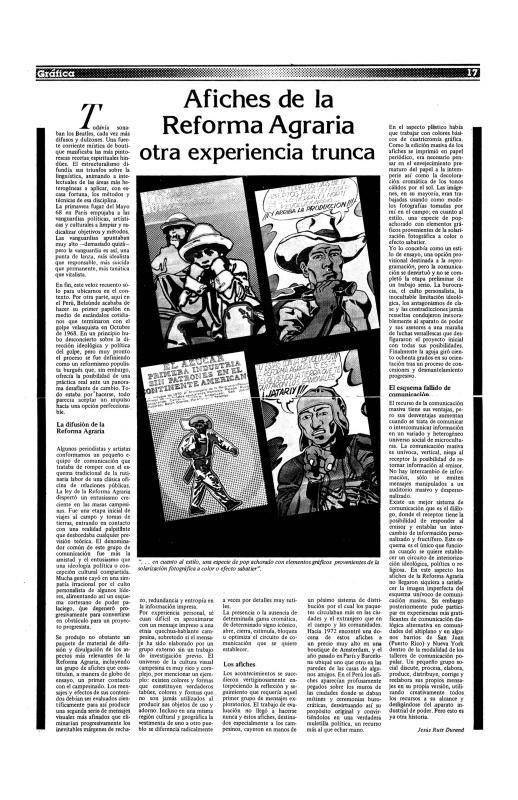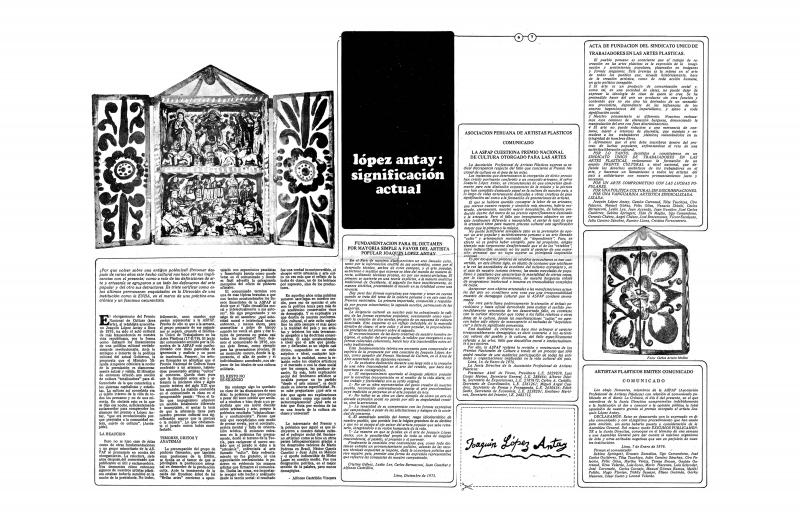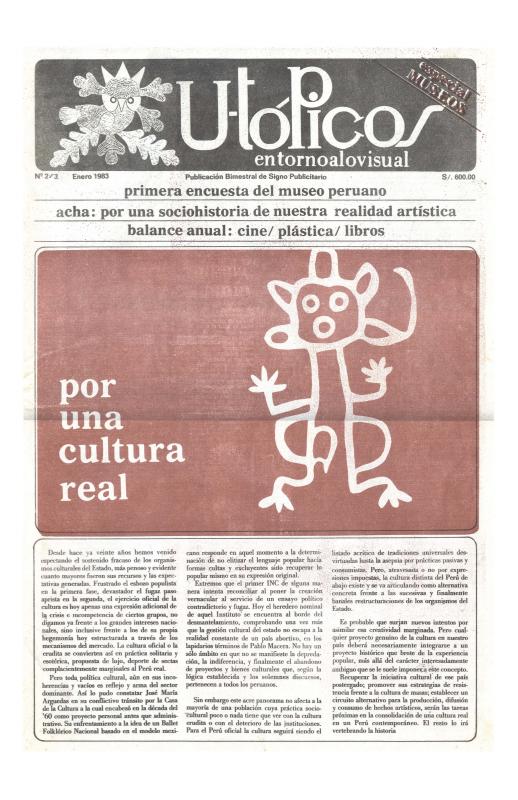Each issue of the magazine was devoted to a particular subject; the third issue (number 4/5), whose back cover is the subject of this document, focused on the practice of art as seen from the perspective of Marxist theory. This text, like the one that introduces the publication and the one about the Chilean art group CADA (Colectivo Acciones de Arte) [Art Actions Collective], discusses the essential concerns regarding the “Marxist aesthetic,” its reappraisal in Latin America, and the development of non-objective art as a potentially truly revolutionary art. Ruiz Durand includes a series of drawings and vignettes in the magazine, entitled A la fecha, casi 5,000 muertes y desapariciones documentadas (which refer to the armed struggle that had taken place in Peru since 1980).
The moderator of the debate between the German intellectual Iring Fetscher and Mirko Lauer for U-tópicos Entornoalovisual magazine was the historian, curator, and critic Gustavo Buntinx, who published articles in various cultural magazines in Lima in the 1980s under the pseudonym Sebastián Gris. He was one of the founders of SUR, Casa de Estudios del Socialismo (Lima) in 1986.
Iring Fetscher came to Lima in 1983 at the invitation of the Goethe Institut and the Universidad de Lima, on the occasion of the one hundredth anniversary of the death of Karl Marx. At that time, he was a professor of political science and social philosophy at the University of Frankfurt and taught at well-known international institutions such as the New School for Social Research in New York (1968–1969), the University of Tel Aviv (1972), the Wassenaar Dutch Institute for Advanced Studies (1972–1973), and Harvard University’s Institute of European Studies (1977). His scientific activities were focused on the study of Rousseau, Hegel, and Marx, with a particular interest in the various directions taken by European Marxism.
Mirko Lauer, for his part, is a distinguished researcher in the field of twentieth-century Peruvian art and literature. He is also a writer and the editor of a number of publications, including the cultural magazine Hueso Húmero, where he and the literary critic Abelardo Oquendo are the directors.
U-tópicos: Entornoalovisual was a magazine that enjoyed a brief lifespan in Peru (only three issues were published, between 1982 and 1984). It was directed by the art historian Alfonso Castrillón (b. 1935), edited (beginning with the second issue) by the art critic Gustavo Buntinx (b. 1957), and designed by Jesús Ruiz Durand (b. 1940), a visual artist who was known for the graphic designs he produced for the General Juan Velasco Alvarado (1968–75) government as part of its reappraisal of the country’s rural population and agricultural sector. The magazine took a social-Marxist approach to art and was part of the broader movement that emerged in Latin America in the 1970s and 1980s as a result of the work of theorists such as the Peruvian Juan Acha (1916–1995) and the Argentinean Néstor García Canclini (b. 1939) (both of whom lived in Mexico), the Brazilian Mario Pedrosa (1900–1981), Mirko Lauer (b. 1947), and the abovementioned Castrillón.
[See the ICAA digital archive for other articles published in the magazine U-tópicos: Entornoalovisual: “Águila, tigre, Che Guevara, Rosa de los Vientos,” by Gustavo Buntinx (doc. no. 1292492); “Afiches de la Reforma Agraria: otra experiencia trunca,” by Jesús Ruiz Durand (doc. no. 1139386); “Desbordar los límites” (anonymous) (doc. no. 1292558); “La necesidad del arte,” by Juan Wilfredo et al (doc. no. 130282); “López Antay: significación actual,” by Alfonso Castríllo Vizcarra (doc. no. 1136495); and “Por una cultura real,” by Hugo Salazar del Alcazar (doc. no. 1292528)].





